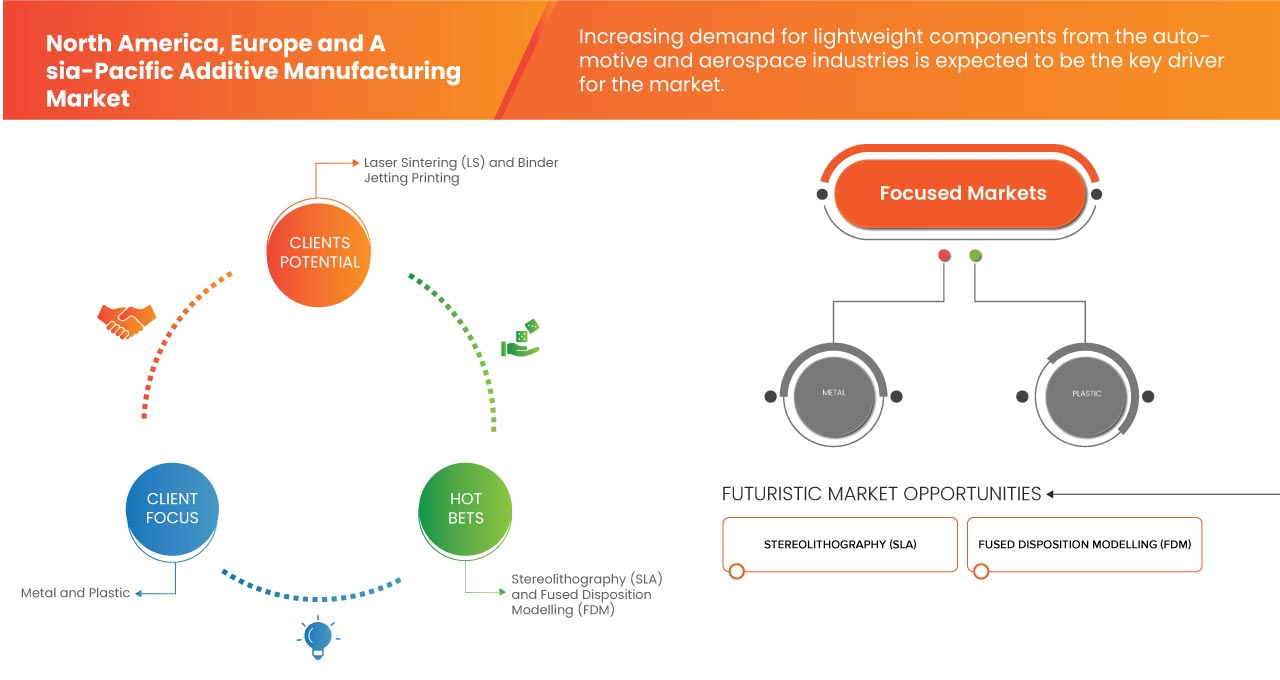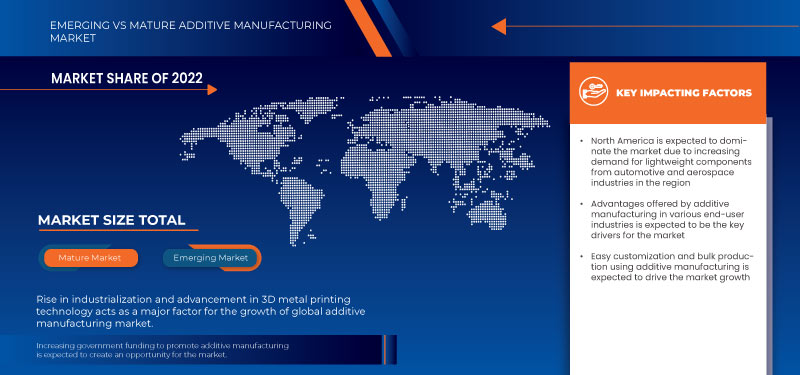North America, Europe and Asia-Pacific Additive Manufacturing Market, By Material Type (Metal, Plastic, Alloys, and Ceramics), Technology (Stereolithography (SLA), Fused Disposition Modelling (FDM), Laser Sintering (LS), Binder Jetting Printing, Polyjet Printing, Electron Beam Melting (EBM), Laminated Object Manufacturing (LOM), and Others), Application (Automotive, Healthcare, Aerospace, Consumer Goods, Industrial, Defense, Architecture, and Others) - Industry Trends and Forecast to 2031.
North America, Europe and Asia-Pacific Additive Manufacturing Market Analysis and Insights
The additive manufacturing market industry is concerned with the design, production and distribution of yarn, cloth, clothing and garments. The raw material may be of metal, plastics, alloys and ceramic. The additive manufacturing industries contribute significantly towards the national economy of many countries. Growing in the demand of lightweight component from the automotive and aerospace categories and advancement in 3D metal printing technologies has highly increase the demand of the additive manufacturing market.
Data Bridge Market Research analyses that the North America, Europe and Asia-Pacific additive manufacturing market is expected to reach USD 88.78 billion by 2031 from USD 21.50 billion in 2023, growing with a CAGR of 19.4% in the forecast period of 2024 to 2031.

The North America, Europe and Asia-Pacific additive manufacturing market report provides details of market share, new developments, and the impact of domestic and localized market players, analyses opportunities in terms of emerging revenue pockets, changes in market regulations, products approvals, strategic decisions, product launches, geographic expansions, and technological innovations in the market. To understand the analysis and the market scenario contact us for an Analyst Brief, our team will help you create a revenue impact solution to achieve your desired goal.
|
Report Metric
|
Details
|
|
Forecast Period
|
2024 to 2031
|
|
Base Year
|
2023
|
|
Historic Years
|
2022 (Customizable to 2016-2021)
|
|
Quantitative Units
|
Revenue in USD Billion
|
|
Segments Covered
|
Material Type (Metal, Plastic, Alloys, and Ceramics), Technology (Stereolithography (SLA), Fused Disposition Modelling (FDM), Laser Sintering (LS), Binder Jetting Printing, Polyjet Printing, Electron Beam Melting (EBM), Laminated Object Manufacturing (LOM), and Others), Application (Automotive, Healthcare, Aerospace, Consumer Goods, Industrial, Defense, Architecture, and Others)
|
|
Countries Covered
|
U.S., Canada, Mexico, Germany, U.K., Italy, France, Spain, Russia, Switzerland, Turkey, Belgium, Netherlands, Rest of Europe, Japan, China, South Korea, India, Singapore, Thailand, Indonesia, Malaysia, Philippines, Australia & New Zealand, and Rest of Asia-Pacific
|
|
Market Players Covered
|
SLM Solutions, Proto Labs, Stratasys, Renishaw plc., Materialise, Titomic Limited., Höganäs AB, YAMAZAKI MAZAK CORPORATION, Markforged, Ultimaker BV, Optomec, Inc., Desktop Metal, Inc., American Additive Manufacturing LLC, ANSYS, Inc., ARBURG GmbH + Co KG, EOS, and Momentum and 3D Systems, Inc., among others
|
Market Definition
Additive Manufacturing (AM) is different from the subtractive method of production, which envisages grinding out unnecessary material from a block of material. The use of additive manufacturing in industrial applications usually refers to 3D printing. Additive manufacturing involves a layer-by-layer addition of material to form an object while referring to a three-dimensional file with the help of a 3D printer and 3D printer software.
North America, Europe and Asia-Pacific Additive Manufacturing Market Dynamics
This section deals with understanding the market drivers, advantages, opportunities, restraints, and challenges. All of this is discussed in detail as below:
Drivers
- Increasing demand for lightweight components from the automotive and aerospace industries
Automotive and aerospace sector required a numerous interacting technical and economic objective of functional performance, lead time reduction, lightweight, cost management and delivery safety-critical component. To meet with the demand and to compensate with the fuel consumption and cost management and to enhance the technical performance and allowable to make an lighter structure which directly related to enhance economic and technical performance and which will help the airlines industry to carry more payload which will directly improve their revenue. Additive manufacturing technologies unlike conventional traditional manufacturing used layer by layer manufacturing based of typical powder or wire and materials like plastic polymer which is of lighter weight.
- Rise in industrialization and advancement in 3D metal printing technology
With the rise in industrialization there are huge demand of 3D metal printing product in industries like aerospace, automotive, health care and other industries. With the demand from various fields like for part in aerospace for their jets engine and another structural part to customize parts in automotive industries to customize design in shoes and other electronic gadget there is a demand in the rigorous development of 3D printing technologies which will perform more efficiently and can produce product at much faster rate with more precision. So demand advancement and convenient of additive manufacturing technologies lead to the increase in the demands of 3D metal printing technologies.
Opportunities
- Advancements in healthcare sector
In the medical field every patients is unique and therefore additive manufacturing has a high potential to be utilized for personalized and customized medical application. The most common medical clinical used are personalized implants, medical models saws guides. In dental fields additive manufacturing products are used in splints, orthodontic appliances, dental models and drill guides. However additive manufacturing products are also used to make artificial tissues and organ which can be used for study purpose in research institute or in between doctor and patients consultation. With the development of digitalizing the medical imaging and that digitalization allows for reconstruction 3D models from patients anatomy. The typical workflow of personalized medical device starts with imaging or capturing the patient’s geometry of the anatomy using computed 3D scanning methods. Such data can be utilized to printed 3D models of patient’s anatomy or can be used to create personalized devices or implants.
- Increasing government funding to promote additive manufacturing
Additive manufacturing has immense potential to revolutionize manufacturing and industrial production landscape through digitals processes, communication and imaging. Additive manufacturing is a trending business which has high demand from various industries like aerospace, automotive, medical sector, electronic, fashion etc. Seeing the potential with the possibility of this sector contribution to the nation economy government of different countries are coming up with different strategy to support and promote this industry.
Restraint/Challenge
- Lack of software efficiency
Additive manufacturing using laser Powder-Bed Fusion (PBF) process has the ability to build complex and intricate shapes along with organic structures which were previously too expensive or complex to make using traditional manufacturing operations. For example, the design freedoms achieved by laser PBF could be exploited to lightweight components, to build the most intricate lattice structures for more efficient material usage. But, laser PBF has its disadvantages that include thin-walled/high-aspect-ratio parts that might fail during a build, difficult-to-remove support structures, layering effects on surface roughness and different process parameter settings such as laser settings for up-skin versus down-skin surfaces.
Recent Development
- In October 2022, Ansys, Inc announced the availability of Ansys Gateway powered by Amazon Web Services (AWS), allowing customers to use popular Ansys products in one unique workspace on AWS – helping simplify access to faster, more flexible, more flexible, and highly scalable engineering solutions. This launch will help the company to gain popularity in innovative solutions
- In October 2022, Ansys, Inc and TSMC continued their long-standing technology collaboration to announce the certification of Ansys’ power integrity software for TSMC’s FINFLEX™ innovation and the TSMC N4 process
- In November 2021, ARBURG GmbH + Co KG announced the merger of its additive manufacturing activities under a newly formed new subsidiary ARBURGadditive GmbH + Co KG. This development helped the company to expand its business in additive manufacturing
- In May 2022, EOS and Sauber Technologies signed a three-year additive manufacturing technology partnership at the Formula (F1) Grand Prix in Barcelona, Spain. This development helped the company to create goodwill
- In November 2022, 3D Systems and ALM announced signed for a partnership to expand access to industry-leading 3D printing materials. ALM will add 3D Systems’ DuraForm® PAx material to its portfolio, providing its customers access to a unique copolymer specifically designed for use with available Selective Laser Sintering (SLS) technologies
North America, Europe and Asia-Pacific Additive Manufacturing Market Scope
The North America, Europe and Asia-Pacific additive manufacturing market is categorized based on material type, technology, and application. The growth amongst these segments will help you analyze major growth segments in the industries and provide the users with a valuable market overview and market insights to make strategic decisions to identify core market applications.
Material Type
- Metal
- Plastic
- Alloys
- Ceramics
Based on material type, the North America, Europe and Asia-Pacific additive manufacturing market is segmented into metal, plastic, alloys, and ceramics.
Technologies
- Stereolithography (SLA)
- Fused Disposition Modelling (FDM)
- Laser Sintering (LS)
- Binder Jetting Printing
- Polyjet Printing
- Electron Beam Melting (EBM)
- Laminated Object Manufacturing (LOM)
- Others
Based on technologies, the North America, Europe and Asia-Pacific additive manufacturing market is segmented into Stereolithography (SLA), Fused Disposition Modelling (FDM), Laser Sintering (LS), binder jetting printing, polyjet printing, Electron Beam Melting (EBM), Laminated Object Manufacturing (LOM), and others.
Application
- Automotive
- Healthcare
- Aerospace
- Consumer Goods
- Industrial
- Defense
- Architecture
- Others
Based on application, the North America, Europe and Asia-Pacific additive manufacturing market is segmented into automotive, healthcare, aerospace, consumer goods, industrial, defense, architecture, and others.
North America, Europe and Asia-Pacific Additive Manufacturing Market Regional Analysis/Insights
The North America, Europe and Asia-Pacific additive manufacturing market is segmented on the basis of material type, technologies, and applications.
The countries covered in the North America, Europe and Asia-Pacific additive manufacturing market are the U.S., Canada, Mexico, Germany, U.K., Italy, France, Spain, Russia, Switzerland, Turkey, Belgium, Netherlands, rest of Europe, Japan, China, South Korea, India, Singapore, Thailand, Indonesia, Malaysia, Philippines, Australia & New Zealand, and rest of Asia-Pacific.
North America is expected to dominate North America, Europe and Asia-Pacific additive manufacturing market due to increasing demand for lightweight components from automotive and aerospace industries in the region. The U.S. is expected to dominate the North America market due to pioneering technology, substantial government and private investment, and early adoption across major industries like aerospace and healthcare. China is expected to dominate the Asia-Pacific market due to rapid industrialization, increasing construction activities, and high demand for paints, coatings, and adhesives, supported by growing infrastructure development and manufacturing sectors. Germany is expected to dominate the Europe market due to its strong engineering tradition, significant investments in research and development, and robust manufacturing sector.
The country section of the report also provides individual market-impacting factors and changes in market regulation that impact the current and future trends of the market. Data point downstream and upstream value chain analysis, technical trends porter's five forces analysis, and case studies are some of the pointers used to forecast the market scenario for individual countries. Also, the presence and availability of regional brands and their challenges faced due to large or scarce competition from local and domestic brands, the impact of domestic tariffs, and trade routes are considered while providing forecast analysis of the country data.
Competitive Landscape and North America, Europe and Asia-Pacific Additive Manufacturing Market Share Analysis
North America, Europe and Asia-Pacific additive manufacturing market competitive landscape provides details by competitors. Details included are company overview, company financials, revenue generated, market potential, investment in research and development, new market initiatives, production sites and facilities, company strengths and weaknesses, product launch, product trials pipelines, product approvals, patents, product width and breadth, application dominance, technology lifeline curve. The above data points provided are only related to the companies’ focus related to the North America, Europe and Asia-Pacific additive manufacturing market.
Some of the prominent participants operating in the North America, Europe and Asia-Pacific additive manufacturing market are SLM Solutions, Proto Labs, Stratasys, Renishaw plc., Materialise, Titomic Limited., Höganäs AB, YAMAZAKI MAZAK CORPORATION, Markforged, Ultimaker BV, Optomec, Inc., Desktop Metal, Inc., American Additive Manufacturing LLC, ANSYS, Inc., ARBURG GmbH + Co KG, EOS, Momentum, and 3D Systems, Inc., among others.
SKU-


